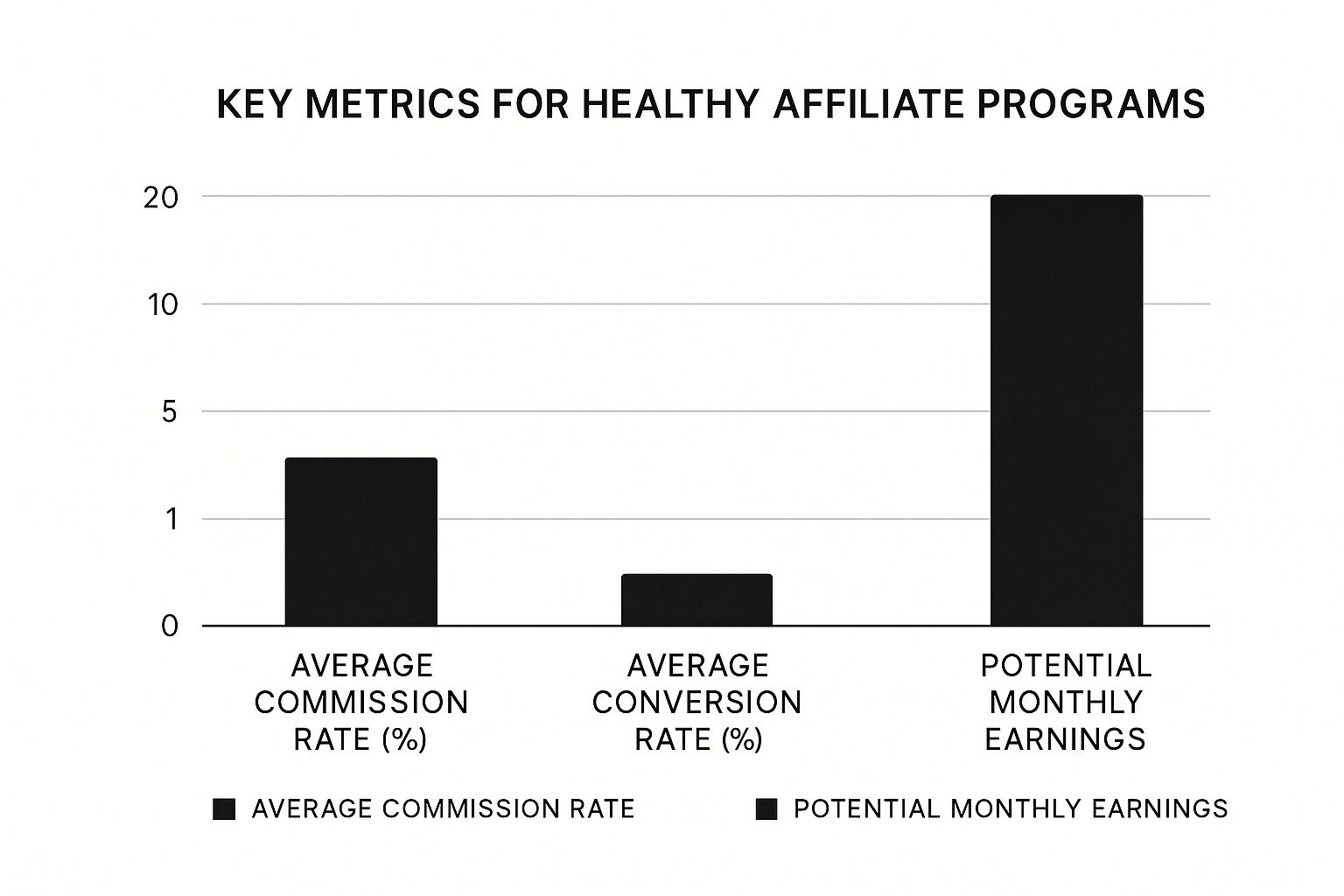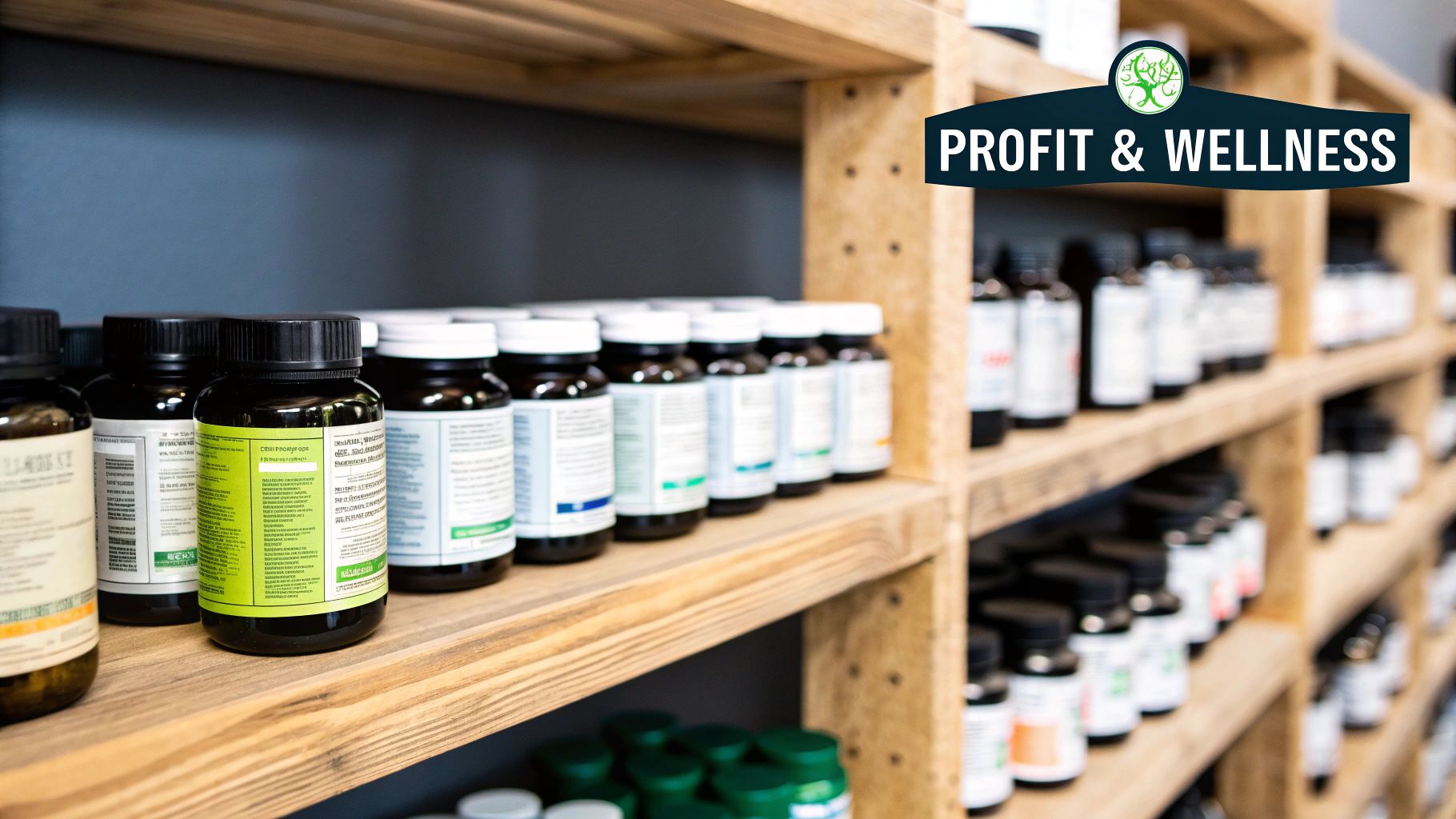A healthy affiliate program isn't about hoarding the most partners. It’s about building a sustainable ecosystem with the right partners. We're talking about a system built on transparent communication, fair commissions, and a shared vision for long-term, profitable growth—for both you and your affiliates. Vanity metrics are out; mutual success is in.
What a Healthy Affiliate Program Looks Like
So many SaaS founders get this wrong. They fall into the "more is better" trap, chasing high affiliate counts and focusing on raw clicks without ever looking at where that traffic comes from. This is a fast track to a bloated, low-performing program that's an administrative nightmare, full of partners sending junk traffic that never converts.
A truly healthy program flips that script. It’s an ecosystem of strategic partnerships, not just a list of transactional relationships. It's crucial to understand what it means to be an affiliate from their side of the table to really grasp this.
A thriving program is defined by a few key traits:
- Selective Partnering: You aren't just accepting anyone who applies. You’re actively recruiting affiliates whose audience and values are a perfect match for your brand.
- Clear Expectations: There’s no gray area. Commission structures, payment terms, and promotional guidelines are crystal clear from day one.
- Mutual Investment: This is a two-way street. You give affiliates the tools, assets, and support they need to win. In return, they promote your product with genuine enthusiasm.
- Data-Driven Decisions: Clicks are just noise. You’re tracking what matters: conversion rates per affiliate, customer lifetime value (LTV), and the percentage of active partners.
The Core Pillars of Program Health
To build this kind of program, you have to get three things right.
First, partner quality is everything. Seriously. One high-performing affiliate who genuinely uses and loves your product is worth a hundred low-effort partners who just slap a link on a coupon site. Prioritize creators, industry experts, and influencers who have already earned the trust of your ideal customers.
Next up is transparent communication. This means having a clear, easy-to-understand affiliate agreement, a dedicated person for partners to contact with questions, and regular updates on product changes or new campaigns. When your partners feel like they're in the loop and supported, their motivation to promote you goes way up.
Finally, you need fair and motivating commissions. This doesn't automatically mean offering the highest percentage on the market. It means creating a structure that’s competitive, simple to understand, and—most importantly—paid reliably and on time. Nothing sours a relationship faster than late payments.
The infographic below shows how these elements come together to drive real-world results.

This data paints a clear picture: stronger commissions and conversion rates directly lead to higher earnings for partners, creating a powerful incentive loop.
The affiliate marketing world is booming. Projections show the industry growing from around $20 billion in 2025 to nearly $40 billion by 2031. With that kind of growth on the horizon, getting your foundation right today is absolutely critical. After all, this channel already accounts for a staggering 16% of all online orders in the U.S.
To help you visualize the difference, here’s a quick breakdown of what separates a winning program from one that’s destined to fail.
Healthy vs Unhealthy Affiliate Program Traits
| Characteristic | Healthy Program | Unhealthy Program |
|---|---|---|
| Recruitment | Selective and strategic | "Accept all" approach |
| Communication | Proactive, clear, and supportive | Reactive or non-existent |
| Focus | LTV and conversion quality | Clicks and sign-up volume |
| Commissions | Fair, motivating, and paid on time | Low, confusing, or delayed |
| Partnerships | Long-term and collaborative | Transactional and short-sighted |
Ultimately, a healthy program is an asset that drives sustainable revenue, while an unhealthy one becomes a cost center that drains time and resources. Choosing the right path from the start makes all the difference.
Pinpointing Your Ideal Affiliate Partners

Here's a hard-earned lesson: the single biggest factor that will make or break your affiliate program is who you partner with.
A program packed with the wrong affiliates is like a high-performance engine filled with cheap gas—it's not going to get you very far, and it might just cause some serious damage. To build a healthy affiliate program, you have to be ruthlessly selective. Quality over quantity isn't just a saying here; it's the entire strategy.
This means you need to look past generic labels like "blogger" or "influencer." The real goal is to build a detailed Ideal Partner Profile (IPP) that becomes your north star for recruitment. This profile gets into the nitty-gritty of what makes a partner a perfect, authentic fit for your brand.
Think about it. You'd never hire a new salesperson without a detailed job description. Affiliate recruitment deserves that same level of strategic thinking.
Crafting Your Ideal Partner Profile
Your IPP is a living document, not a static checklist. It defines the non-negotiables of your perfect affiliate. This has less to do with their audience size and everything to do with audience alignment.
To start building your profile, ask yourself a few fundamental questions:
- Audience Demographics: Do their followers or readers look like your best customers? Think about specifics: industry, job titles, location, and even company size.
- Content Niche: Is there a natural, obvious overlap between their content and your SaaS? If you sell a tool for writers, you need to partner with people who teach writing, not just any generic business coach. The fit has to be seamless.
- Brand Values: Does their tone and mission feel like a natural extension of your own? A partnership that feels forced or "off" can erode trust with both of your audiences instantly.
- Engagement Quality: Forget follower counts for a second. Look at their comments. Are people having real conversations, or is it just a wall of spam and emojis? Real engagement is where the magic happens.
Key Takeaway: An Ideal Partner Profile isn't a wishlist; it's a strategic filter. It ensures every partner you recruit has a built-in audience that is predisposed to care about what your SaaS offers, dramatically increasing the odds of successful conversions.
Beyond the Follower Count
I've seen too many programs get burned by chasing vanity metrics. A creator with 100,000 followers and a dismal 0.5% engagement rate is far less valuable than someone with 10,000 highly-engaged followers hitting a 5% engagement rate.
True influence is built on trust and interaction, not just a big number.
Look for signs of a healthy, thriving community. Are there thoughtful comments? Are people sharing the content? Does the creator actually jump into the comments and talk to their audience? These are the partners who can drive real action, not just empty clicks. For a deeper dive, our guide on how to find affiliates for your program has more hands-on tactics.
Research and Vetting Your Prospects
Once you've defined your IPP, the hunt begins. This is an active search, not a passive "build it and they will come" situation.
- Analyze Your Customer Base: Who already loves your product? Your most passionate customers often make the most authentic affiliates. They've already got the success stories to share.
- Explore Niche Communities: Go to the places where your ideal customers hang out online. I'm talking about specific subreddits, focused Facebook groups, Slack channels, and industry forums. The people leading conversations in those spaces are your prime candidates.
- Use Keyword Research: Search for the problems your SaaS solves. The websites, YouTube channels, and podcasts that show up are already reaching an audience that is actively looking for a solution just like yours.
As you vet potential partners, keep an eye out for red flags. An unnaturally high follower-to-engagement ratio, bot-like comments, or a history of promoting sketchy products are all clear signs to stay away. A successful program is built on a foundation of trust, and that starts with recruiting partners you can trust.
Designing Commissions That Actually Motivate

Let's be blunt: your commission structure is the engine of your entire affiliate program. If you get this wrong, you're pretty much doomed from the start. A weak or confusing payout plan won't just fail to attract top talent—it will actively push them away while attracting low-quality partners who might do more harm than good.
The trick is finding that sweet spot between what gets your partners excited and what makes financial sense for your business. You're not just paying for a click; you're building a partnership that rewards real value and encourages long-term loyalty.
When you design a structure that aligns your affiliates' success with your own, you're sending a powerful message. It shows you're serious about building a mutually profitable relationship.
Choosing Your Commission Model
There’s no magic bullet here. The right model for you hinges on your SaaS product's price point, typical sales cycle, and, most importantly, your customer lifetime value (LTV). Let's walk through the most common approaches I've seen work in the real world.
Percentage-Based Commissions: This is the go-to for most SaaS companies, and for good reason. You offer affiliates a cut of the sale, which can be a one-time payment or, even better, a recurring one. For a subscription business, recurring commissions are incredibly powerful. A 25% recurring commission on a $49/month plan means the affiliate earns $12.25 every single month that customer stays subscribed. This gives partners a massive incentive to find sticky, high-quality users, not just drive quick sign-ups.
Flat-Fee Commissions: This is as straightforward as it gets. You offer a fixed amount, like $50 for every new customer, for each successful referral. This model is perfect for products with a single price point or when you just want to keep things simple. The predictability is a huge plus for both you and your affiliates.
Tiered Commissions: This is how you light a fire under your best performers. You create performance-based tiers to reward high volume. For instance, partners driving 1-10 sales a month might earn 20%, but once they hit 11-25 sales, that rate jumps to 30%. It gamifies the experience and gives your top affiliates a clear, motivating goal to shoot for.
The affiliate marketing world is booming. U.S. spending alone has skyrocketed from $9.1 billion in 2021 and is projected to hit $13.62 billion in 2024. With that much money on the table, a competitive commission structure is non-negotiable if you want to attract the best partners. You can see more on this industry growth from the PMA.
My Two Cents: For the vast majority of SaaS businesses, a recurring, percentage-based commission is the gold standard. It creates perfect alignment. Your affiliates are directly motivated to bring in customers who will stick around, which boosts your MRR and helps you fight churn.
The Technical Details That Build Trust
Beyond the numbers, a couple of technical settings are absolutely critical for building trust. If you mess these up, you can quickly sour relationships and earn a bad reputation in the affiliate community.
Cookie Duration
This little setting determines how long an affiliate gets credit for a sale after someone clicks their link. A short cookie window—like 24 hours—is a huge source of frustration. A potential customer might read an affiliate's in-depth review, think it over for a few days, and then come back to your site directly to buy. With a short cookie, that affiliate gets nothing for their hard work.
A 30 to 90-day cookie duration is widely considered the industry standard. It’s fair, it respects the affiliate’s role in a longer buying journey, and it shows you value their influence beyond that first click.
Attribution Model
Attribution decides who gets paid if a customer clicks links from multiple affiliates. The most common and straightforward model is "last click," where the final affiliate link clicked before the purchase gets 100% of the commission. It's clean and easy to track.
While more complex models exist, last-click remains the standard for its simplicity. The most important thing is to be completely transparent about your attribution model in your affiliate terms. No one likes surprises when it comes to their paycheck. If you want to dive deeper, we have a complete guide on how to calculate commission percentages effectively for your program.
Recruiting and Onboarding Your Top Affiliates

Finding the right partners is one thing, but that's only half the battle. The real work—the part that separates a thriving program from a dead one—is convincing them to join and then getting them up to speed quickly. A sloppy, impersonal approach here can tank a great potential partnership before it even gets off the ground.
Think about it from their perspective. The best affiliates get dozens of generic, low-effort invites every week. Your outreach has to cut through that noise. This isn't a "spray and pray" numbers game; it's about showing a potential partner you've done your homework and genuinely believe in the value you can create together.
Bottom line: your recruitment and onboarding process needs to be as polished as your product. It’s the very first impression an affiliate has of your company, and you only get one shot to make it a good one.
Crafting Outreach That Actually Gets a Reply
Let’s be honest: generic email blasts are a waste of time. The secret to getting a "yes" is personalization. Your email needs to make it immediately obvious that you understand their content, respect their audience, and see a real, mutual fit.
Before you write a single word, make sure you can answer these three questions from their point of view:
- “Why me, specifically?” Don't just say you like their blog. Reference a specific article, podcast episode, or video and explain why it made you think of them. Show them you're a real person who has engaged with their work.
- “What’s in it for my audience?” Your product isn't just another thing to promote; it’s a solution for their followers. Frame it that way. Explain how you help solve a problem they already talk about.
- “What’s in it for me?” Be direct and transparent about your commission structure and any other perks. Top affiliates are business owners; they need to see a clear path to making money.
Pro Tip: Keep your first email short and to the point. The goal is to start a conversation, not send them a novel. A brief, impactful message that respects their time is far more likely to get a response than a wall of text.
The Power of a Dedicated Affiliate Landing Page
So you’ve got their attention. Now what? Sending them to your generic homepage is a huge mistake. You need to direct them to a dedicated landing page built specifically to sell them on your program.
This page is your program's sales pitch. It needs to be clear, persuasive, and answer all their initial questions. Make sure it includes:
- A Compelling Headline: Something like, "Partner with [Your Brand] and Earn Recurring Revenue." Get straight to the benefit.
- Your Ideal Partner: Briefly describe who you're looking for. This helps prospects self-qualify and shows you're serious about quality.
- Commission Details: Be upfront about the commission rate, whether it’s recurring or a flat fee, and the cookie duration.
- Program Benefits: What makes your program stand out? Mention things like high-converting marketing assets, a dedicated manager, or exclusive partner deals.
- A Clear Call-to-Action: Your "Apply Now" button should be big, bold, and impossible to miss.
This simple page makes you look professional and organized. It's a critical piece of infrastructure for building a program that can scale.
Building an Unforgettable Onboarding Experience
You got a yes! Now the real relationship-building begins. A phenomenal onboarding experience is the single best way to get a new partner activated and making sales right out of the gate.
Your goal here is to remove all friction. Give them everything they need to start promoting you effectively without having to ask. Don't just send a login and wish them luck—send them a complete welcome kit.
To ensure your new affiliates have everything they need for a smooth start, we've put together a simple checklist. This isn't just about providing information; it's about showing you're organized and invested in their success from day one.
Your Affiliate Onboarding Checklist
| Checklist Item | Purpose | Status |
|---|---|---|
| Personalized Welcome Email | A warm note from their affiliate manager that sets a collaborative and positive tone. | ☐ |
| Getting Started Guide | A simple, visual guide on how to grab their links and understand the dashboard. | ☐ |
| Marketing Asset Library | A link to a folder with approved logos, screenshots, email copy, and social media templates. | ☐ |
| Brand & Promotion Guidelines | A clear document outlining the do's and don'ts of promoting your brand to maintain consistency. | ☐ |
| Direct Point of Contact | The name, email, and maybe even a Calendly link for their dedicated affiliate manager. | ☐ |
Ticking these boxes turns a simple sign-up into the start of a real partnership. It demonstrates that you're just as invested in their success as they are, which is the foundation of any healthy, long-term affiliate relationship.
Managing and Scaling Your Program for Growth
https://www.youtube.com/embed/SLABmxxSIP8
Getting your affiliate program off the ground is a huge first step, but the real work starts now. The day-to-day management and smart scaling are where you’ll find sustainable growth. A program left on autopilot after launch will stall out, fast.
To build a healthy affiliate program, you need to shift from a "launch" mindset to a "cultivation" mindset. This is all about actively working with your partners, digging into the performance data, and constantly tweaking your approach. Think of it as building an ecosystem, not just a list of links.
The global affiliate marketing industry was valued at over $17 billion in 2025, and it's growing by about 10% every year. With 81% of brands already running these programs, it's a competitive field. But for those who manage their programs well, the rewards are massive.
Fostering Engagement Through Communication
Your best affiliates are true partners, not just marketers. The secret to unlocking their potential is simple: consistent, valuable communication. Radio silence is the quickest way to make a partner feel ignored and lose interest.
A simple communication rhythm is all you need to stay top-of-mind.
- Monthly Newsletters: Keep them in the loop with product updates, new features, and fresh marketing assets. It’s also a great place to highlight top-performing affiliates (with their permission, of course) to inspire others.
- One-on-One Check-ins: For your top 5-10% of partners, a quick quarterly call goes a long way. Ask what’s working, what isn’t, and what they need from you. That personal touch builds incredible loyalty.
This kind of proactive communication does more than just share news. It reinforces the partnership and makes your affiliates feel like they're part of the inner circle, making them far more invested in your success.
Running Promotions That Energize Your Affiliates
Every now and then, your program needs a jolt of energy. Well-timed promotions can motivate both new and existing partners to double down on their efforts. These aren’t just random discounts; they should be strategic campaigns built to hit specific goals.
Here are a couple of ideas that work wonders:
- Commission Boosts: For a limited time, bump up your commission rate—say, from 25% to 35% for a month. This is a fantastic way to drive a sales surge around big events like Black Friday or a major product launch.
- Performance Bonuses: Fire up some friendly competition with a tiered contest. For example, offer an extra $100 for any affiliate who drives over 10 sales in a month and $500 for anyone who hits 50.
Incentives like these create a sense of urgency and get your partners trying new things. For a program that can truly scale, integrating some smart marketing automation best practices can help manage everything from recruitment to tracking these very promotions.
Monitoring Key Performance Indicators for Health
You can't fix what you don't measure. Forget vanity metrics like raw click counts; you need to focus on the KPIs that reveal the true health of your program and your partners' engagement.
Crucial Insight: One of the most telling metrics is your Active Affiliate Rate—the percentage of affiliates who have driven at least one click or sale in the last 90 days. If this rate drops below 10%, you likely have an onboarding or engagement problem that needs immediate attention.
Here are the numbers you should be tracking obsessively:
- Conversion Rate per Affiliate: This tells you who is sending you high-quality traffic. An affiliate with 100 clicks and 10 sales (10% conversion) is infinitely more valuable than one with 1,000 clicks and 2 sales (0.2% conversion).
- Average Order Value (AOV) per Affiliate: Are some partners bringing in bigger customers? Pinpoint who they are and study their methods—you might learn something you can share with everyone else.
- Revenue per Affiliate: At the end of the day, this is what matters most. See who your top revenue drivers are and invest more of your time and resources into helping them succeed even more.
Diving into this data helps you make smarter decisions. You’ll know which partners to nurture, who needs a helping hand, and which low-performers might need to be pruned from the program. This data-driven strategy is at the core of how you manage an affiliate program for long-term growth.
Answering Your Top Affiliate Program Questions
Once you've got the blueprint for your affiliate program, the real-world questions start popping up. Moving from strategy to execution is where the rubber meets the road. I get asked these all the time, so let's dig into the practical side of turning your affiliate idea into a revenue engine.
What's a Realistic Budget for a New Program?
This is a big one, and it's easy to overcomplicate. Your budget really boils down to two things: the tech you use and the commissions you pay. Thinking of it as a fixed monthly cost is a common mistake.
First, you have your software. A solid affiliate management platform can run anywhere from $50 to over $500 a month, all depending on how fancy you need to get with features. This is your main fixed expense.
The much bigger piece of the puzzle is commissions, which is a variable cost. Instead of guessing a number, think in terms of your Cost Per Acquisition (CPA). Figure out the absolute most you're willing to spend to land a new customer. From there, you can work backward to create a commission structure that keeps you profitable.
For example, let's say your customer's lifetime value (LTV) is $500 and you've set your target CPA at $75. If you offer a 25% commission on a $200 annual plan, that's a $50 payout. You've acquired a great new customer and still have a healthy margin.
For a brand new program, I usually recommend earmarking around $1,000–$2,000 to cover your software and the first couple of months of commissions. This gives you enough runway to get things moving.
How Do I Actually Prevent Affiliate Fraud?
Look, affiliate fraud is a constant cat-and-mouse game. There's no "set it and forget it" solution. The only way to protect your program is with a proactive, layered defense. It all starts with a hands-on approach.
- Manually Vet Every Applicant: Seriously, don't just automate approvals. Take five minutes to look at every single application. Check out their website, their social channels, and the quality of their content. Does it feel like a genuine fit for your brand? Is their audience your audience?
- Lean on Fraud Detection Tools: Most good affiliate software comes with built-in fraud detection. These tools are your first line of defense, automatically flagging shady stuff like click spamming, cookie stuffing, or traffic coming from known bot farms.
- Set Crystal-Clear Terms: Your affiliate agreement needs to be explicit about what's not allowed. Make sure you forbid common shenanigans like bidding on your branded keywords, making bogus claims about your product, or promoting unapproved coupon codes.
My Two Cents: Get in the habit of regularly auditing your program's data. If you see a partner with a sky-high conversion rate but their referrals have an equally high refund rate, that's a massive red flag. Don't hesitate to investigate and kick out anyone breaking the rules. A clean program is a profitable one.
How Long Until I See Real Results?
Patience is a virtue here, and it's where a lot of people get tripped up. You aren't just flipping a switch for instant sales, even though you might get a few early wins.
Realistically, it takes a solid 6 to 12 months to build a predictable, meaningful revenue stream from affiliates.
Here’s what that timeline usually looks like from my experience:
- Months 1-3: You're laying the groundwork. This is all about getting your tech dialed in, creating compelling swipe copy and creative assets, and recruiting your first wave of partners.
- Months 3-6: The focus shifts to partner activation. You're analyzing the early data, figuring out which partners are getting traction, and giving them the support they need to really start promoting.
- After 6 Months: This is where things get exciting. You should start seeing more consistent, predictable growth. Your best partners have hit their stride, and the program starts feeling like a reliable part of your marketing mix.
Remember, this is a marathon, not a sprint. The whole game is about consistent effort—recruiting, building relationships, and always optimizing.
Should I Use an Affiliate Network or Go It Alone?
This is the classic fork in the road, and the right path depends almost entirely on your resources—specifically, your time and your team's know-how.
Affiliate Networks (like ShareASale or CJ Affiliate)
- The upside? Networks give you a ready-made army of affiliates to tap into from day one. They also handle the headaches of payment processing and tracking, which is a lifesaver for small teams.
- The downside? You're paying network fees that can slice into your margins, and you lose that direct, personal connection with your partners because the network is always in the middle.
Independent Programs (using software like Tapfiliate)
- The upside? You're in the driver's seat. You own the program, build direct relationships, and keep all of your margin instead of paying network fees. Long-term, this is almost always more profitable.
- The downside? The buck stops with you. You're on the hook for everything: recruitment, management, tech, and payouts. It’s a serious time commitment, especially at the start.
If you have the bandwidth and desire to build real, lasting relationships with your partners, running an independent program is the way to go. If you just need to get moving fast, a network can be a decent launchpad.
Ready to build a healthy affiliate program without the hassle of external networks? Refgrow lets you launch a fully native, embeddable affiliate dashboard directly inside your SaaS in minutes. Start your free trial today and take control of your partnerships.

